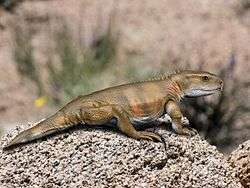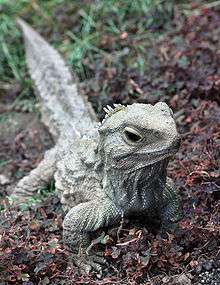Kaikaifilusaurus
Kaikaifilusaurus is an extinct genus of rhynchocephalians in the family Sphenodontidae from the Late Cretaceous of South America. Fossils of the genus were found in Cenomanian sediments of the Candeleros Formation and Turonian layers of the Huincul Formation, both of the Neuquén Basin and the Albian strata of the Cerro Barcino Formation in the Cañadón Asfalto Basin, all in Patagonia, Argentina. The genus contains two species, K. minimus and the type species K. calvoi.[1]
| Kaikaifilusaurus | |
|---|---|
 | |
| Reconstruction of Kaikaifilusaurus | |
| Scientific classification | |
| Kingdom: | |
| Phylum: | |
| Class: | |
| Superorder: | |
| Order: | |
| Family: | |
| Subfamily: | Eilenodontinae |
| Genus: | †Kaikaifilusaurus Simón & Kellner 2003 |
| Type species | |
| Kaikaifilusaurus calvoi Simón & Kellner 2003 | |
| Species | |
| |
| Synonyms | |
| |
Etymology
The genus name Kaikaifilusaurus is derived from the Greek sauros, meaning "lizard" and Kaikaifilu, coming from Mapudungun, the language of the Mapuche. In their cosmology, Kai-Kai filú is the almighty giant reptile owner of the seas, a rival of Treng-Treng filú, "both creators of the lands through their continuous fight that causes the earthquakes, volcanoes, tsunamis and all the events that molded the earth where we live". The same etymology has been used for the mosasaur genus Kaikaifilu from the Lopez de Bertodano Formation of Antarctica.[2]
Classification
The present type species of Kaikaifilusaurus, K. calvoi, was described by Simón and Kellner in 2003, based on type specimen MPCHv 4, a mandible (left lower jaw) from the Candeleros Formation. In the same year, Priosphenodon avelasi was described by Apesteguía and Novas in 2003, based on type specimen MPCA 300, a partially articulated adult skeleton from the Cenomanian fluvial sandstones of the Candeleros Formation in the Neuquén Basin.
Gentil et al. in 2019 reassigned P. avelasi as a junior synonym of Kaikaifilusaurus calvoi.[3] Gentil et al. placed the second species of Priosphenodon, P. minimus, in 2014 described by Apesteguía and Carballido based on the type specimen MPEF-PV 3166, a skull (almost complete skull with attached jaws, from the Albian Cerro Barcino Formation of the Cañadón Asfalto Basin,[4] in the same genus of Kaikaifilusaurus as K. minimus. Apesteguía and Carballido had considered Kaikaifilusaurus a nomen dubium.[3]
The 2019 researchers described another specimen of Kaikaifilusaurus; MPCA-PV 808, an incomplete right dentary from the Turonian strata of the Huincul Formation of the Neuquén Basin.[3][5]
Gentil et al. (2019) place the genus Kaikaifilusaurus in the subfamily Eilenodontinae of the order Sphenodontia.[3]
Description
The fossil of Kaikaifilusaurus sp. described by Gentil et al. in 2019 comprises a fragment of 14.6 millimetres (0.57 in) long preserving nine teeth, presenting an acrodont implantation and a nearly straight anteroposterior linear arrangement.[3]
Adult specimens of Kaikaifilusaurus are estimated to reach 1 metre (3.3 ft) in length, larger than previously known terrestrial sphenodontian.[6]
Paleoecology
The fossil record of Kaikaifilusaurus ranges from the Albian to the Turonian, straddling the boundary between the Early and Late Cretaceous. The oldest record (the K. minimus type locality) of the genus comes from the La Paloma Member of the Cerro Barcino Formation of the Cañadón Asfalto Basin in north-central Patagonia, Argentina.[7] During this time, the paleoclimate of the La Paloma Member of the formation was arid,[8] and the depositional environment comprised a playa lake with debris flows system, dominated by pyroclastic deposits with intercalated dune sediments.[7][9] The same member has provided fossils of Chubutemys copelloi and an indeterminate theropod.[10]
The fossil remains of Kaikaifilusaurus from the Candeleros Formation hail from Cenomanian fluvial red sandstones and conglomerates.[11] The formation comprises eolian and paleosol deposits, as well as sediments deposits in a braided river environment. Fossils of one of the largest theropods known, Giganotosaurus carolinii were found in this succession,[12] as well as frogs, mammals and fish.[13]
The youngest record of the genus occurs in the Huincul Formation, overlying the Candeleros Formation in Neuquén Basin. The formation represents an arid environment with ephemeral or seasonal streams. The same locality where Kaikaifilusaurus was found, has provided abundant fossils of lepisosteid fish, chelid turtles, lizards, neosuchian crocodyliforms, ornithopods, titanosaurian sauropods and diverse theropods including abelisaurids, carcharodontosaurids, and megaraptorans.[5] The dinosaurs Gualicho shinyae, Argentinosaurus huinculensis, Mapusaurus rosae, Cathartesaura,[14] Ilokelesia,[15] and Skorpiovenator bustingorryi,[16] come from this formation.[17]
See also
References
- Kaikaifilusaurus at Fossilworks.org
- Otero et al., 2017, p.211
- Gentil et al., 2019, p.74
- Apesteguía & Carballido, 2014, p.304
- Gentil et al., 2019, p.73
- Apesteguía & Novas, 2003, p.609
- Tres Cerros; Priosphenodon minimus type locality at Fossilworks.org
- Rauhut et al., 2003, p.495
- Rauhut et al., 2003, p.491
- Turtle Town, Cerro Barcino at Fossilworks.org
- Araceli, on Bustingorry farm, Candeleros Formation at Fossilworks.org
- Sánchez et al., 2006, p.4
- Leanza, 2004, p.68
- Gallina & Apesteguía, 2005 p.154
- Coria & Salgado, 1998, p.91
- Canale et al., 2008, p.410
- Apesteguía et al., 2016, p.2
Bibliography
- Kaikaifilusaurus
- Apesteguía, Sebastián, and Guillermo W. Rougier. 2007. A Late Campanian Sphenodontid Maxilla from Northern Patagonia. American Museum Novitates 3581. 1–12. Accessed 2019-03-30.
- Apesteguía, Sebastián, and José L. Carballido. 2014. A New Eilenodontine (Lepidosauria, Sphenodontidae) from the Lower Cretaceous of Central Patagonia. Journal of Vertebrate Paleontology 34. 303–317. Accessed 2019-03-30.
- Apesteguía, Sebastián, and Fernando E. Novas. 2003. Large Cretaceous sphenodontian from Patagonia provides insight into lepidosaur evolution in Gondwana. Nature 425. 609–612. Accessed 2019-03-30.
- Gentil, A.R.; F.L. Agnolín; J.A. García Marsà; M.J. Motta, and F.E. Novas. 2019. Bridging the gap: sphenodont remains from the Turonian (Upper Cretaceous) of Patagonia. Palaeobiological inferences. Cretaceous Research 98. 72–83. Accessed 2019-03-30.
- Otero, Rodrigo A.; Sergio Soto Acuña; David Rubilar Rogers, and Carolina S. Gutstein. 2017. Kaikaifilu hervei gen. et sp. nov., a new large mosasaur (Squamata, Mosasauridae) from the upper Maastrichtian of Antarctica. Cretaceous Research 70. 209–225. Accessed 2019-03-30.
- Paleoecology
- Apesteguía, Sebastián; Nathan D. Smith; Rubén Juárez Valieri, and Peter J. Makovicky. 2016. . PLoS ONE 11. 1–41. Accessed 2019-03-30.
- Canale, J.I.; C.A. Scanferla; F. Agnolín, and F.E. Novas. 2008. New carnivorous dinosaur from the Late Cretaceous of NW Patagonia and the evolution of abelisaurid theropods. Naturwissenschaften 96. 409–414. Accessed 2019-03-30.
- Coria, R.A., and P.J. Currie. 2006. A new carcharodontosaurid (Dinosauria, Theropoda) from the Upper Cretaceous of Argentina. Geodiversitas 28. 71–118. Accessed 2019-02-16.
- Coria, Rodolfo A., and Leonardo Salgado. 1998. A Basal Abelisauria Novas, 1992 (Theropoda-Ceratosauria) from the Cretaceous of Patagonia, Argentina. Gaia 15. 89–102. Accessed 2019-03-30.
- Gallina, Pablo A., and Sebastián Apesteguía. 2005. Cathartesaura anaerobica gen. et sp. nov.,a new rebbachisaurid (Dinosauria, Sauropoda) from the Huincul Formation (Upper Cretaceous), Rio Negro, Argentina. Revista del Museo Argentino de Ciencias Naturales, Nueva Serie 7. 153–166. Accessed 2019-03-30.
- Leanza, H.A.; S. Apesteguia; F.E. Novas, and M.S. De la Fuente. 2004. Cretaceous terrestrial beds from the Neuquén Basin (Argentina) and their tetrapod assemblages. Cretaceous Research 25. 61–87. Accessed 2019-02-16.
- Rauhut, O.W.M.; G. Cladera; P. Vickers-Rich, and T.H. Rich. 2003. Dinosaur remains from the Lower Cretaceous of the Chubut Group, Argentina. Cretaceous Research 24. 487–497. Accessed 2019-03-30.
- Sánchez, María Lidia; Susana Heredia, and Jorge O. Calvo. 2006. Paleoambientes sedimentarios del Cretácico Superior de la Formación Plottier (Grupo Neuquén), Departamento Confluencia, Neuquén (Sedimentary paleoenvironments in the Upper Cretaceous Plottier Formation (Neuquen Group), Confluencia, Neuquén). Revista de la Asociación Geológica Argentina 61. 3–18. Accessed 2019-02-16.
Further reading
- Simón, M.E., and A.W.A. Kellner. 2003. New sphenodontid (Lepidosauria, Rhynchocephalia, Eilenodontinae) from the Candeleros Formation, Cenomanian of Patagonia, Argentina. Boletim do Museu Nacional, Geologia, nova série 68. 1–12.
